Australia
In an age of instant emails and quick messages, the formal business letter format can feel a bit like a relic from the past. But don't be fooled. It remains a powerful and essential tool for any communication that demands authority, seriousness, and a permanent record. Learning to master this format isn't just an old-school skill; it's a strategic move that cuts through digital noise and commands respect.
Why Your Business Letter Format Still Matters
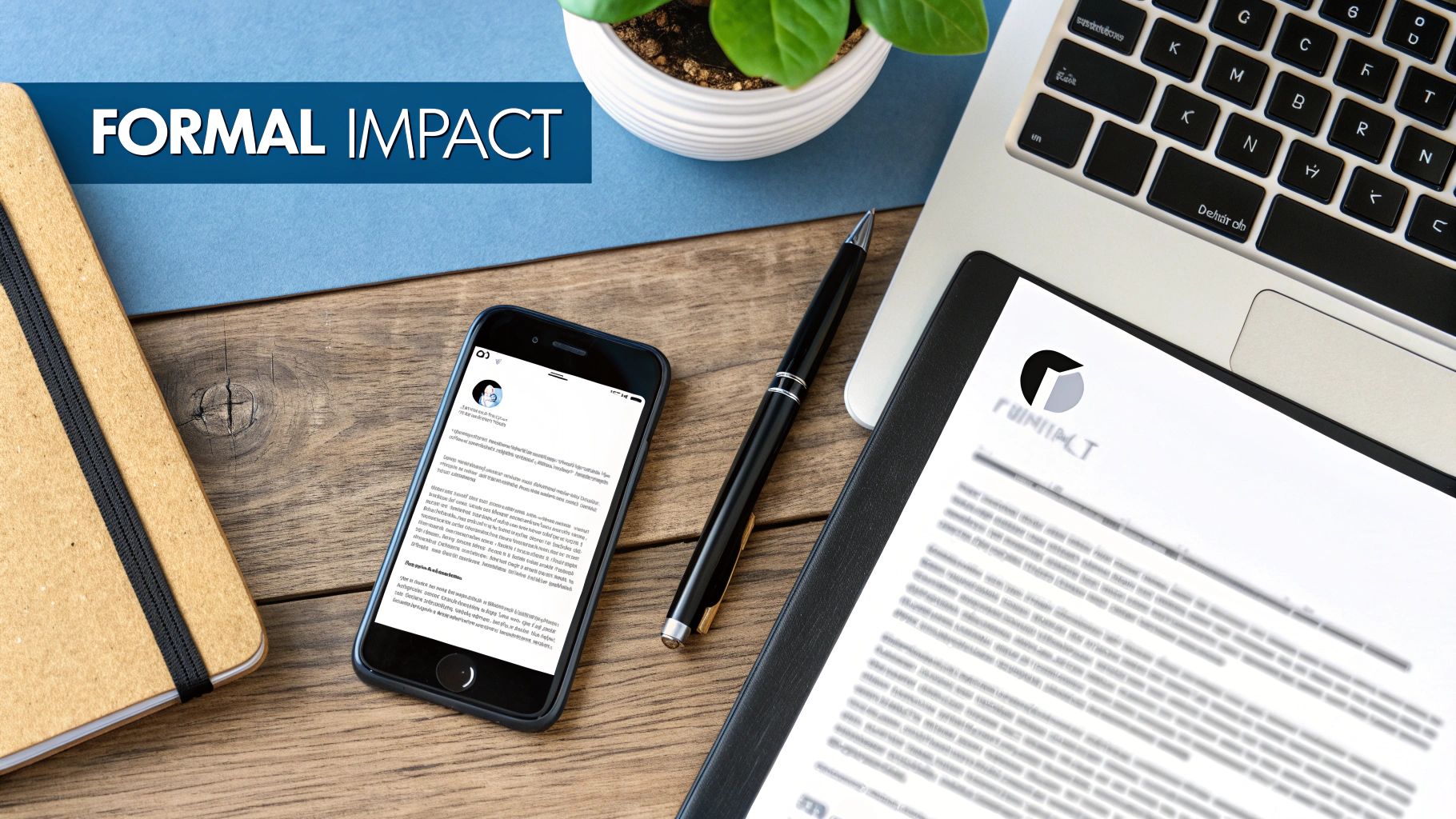
Think of your communication tools like a wardrobe. Emails and instant messages are your casual wear—perfect for everyday, informal chats. A formal business letter, on the other hand, is your perfectly tailored suit. You choose it for the moments that truly count, sending a clear signal of importance, respect, and professionalism.
This distinction is especially crucial in the Australian business world. While digital is fast and efficient, it often lacks the psychological weight of a physical document. A well-structured letter shows you’ve invested time and care into your message, which immediately elevates its value in the recipient's mind.
Establishing Authority and Creating a Record
Some situations just demand a level of formality that a quick email can't deliver. The deliberate, structured nature of a business letter format makes it the undisputed standard for:
- Legal Notices: Providing an official, dated record of communication.
- Formal Proposals: Presenting significant business opportunities with the gravity they deserve.
- Official Correspondence: Communicating with government bodies or senior executives.
- Job Applications: Making a strong first impression that screams professionalism.
In these high-stakes scenarios, the format is part of the message. It tells the recipient that the contents are important and need to be treated that way.
A precisely formatted letter doesn’t just share information; it establishes credibility. It cuts through the endless stream of digital notifications to create a tangible, focused moment of communication, ensuring your message is not just seen, but seriously considered.
The Enduring Role of Formal Mail
Even with the massive shift to digital, formal mail remains a cornerstone of official business in Australia. While overall domestic letter volumes have dropped, business-related mail like bills and official statements still dominates the landscape.
In fact, a recent report found these types of letters made up 65% of all letter volumes in 2023/24. This highlights a persistent, undeniable need for a standardised format in transactional and formal communications.
This reality makes it clear that the skills needed to produce these documents are far from obsolete. For any organisation, investing in comprehensive business writing skills training can sharpen overall communication and professional impact. It ensures every team member can represent the company with polish and precision. Mastering the business letter format isn't just about following rules; it's about wielding a powerful tool for effective and authoritative communication.
The Anatomy of a Professional Business Letter
Think of a professional business letter as a carefully constructed building. Each component has a specific place and purpose, and when they’re assembled correctly, they create a structure that is strong, clear, and professional. Straying from this blueprint can make your entire message feel unstable or unprofessional.
This section is your architectural plan. We'll deconstruct the business letter format into its core elements, starting from the very foundation—your contact information—and building our way up, piece by piece. Understanding not just what each part is, but why it's there is the key to mastering formal correspondence.
Starting at the Top: Your Contact Information
The first thing on the page, right at the top, is your contact information. This is essentially the return address, making it crystal clear to the recipient who the letter is from and how they can get back to you.
For a professional look, make sure you include:
- Your Full Name: Or your company's name.
- Your Street Address: Line one for the street, line two for the suburb, state, and postcode.
- Your Phone Number: A direct line of contact is always a good idea.
- Your Email Address: An absolute must for modern communication.
This block of information sets the stage, establishing your identity before a single word of your message is even read. Of course, if you're using official company letterhead, this is usually pre-printed, so you can skip this step.
The infographic below breaks down the three main zones of a business letter, showing where your details, the recipient's address, and the signature block typically sit.
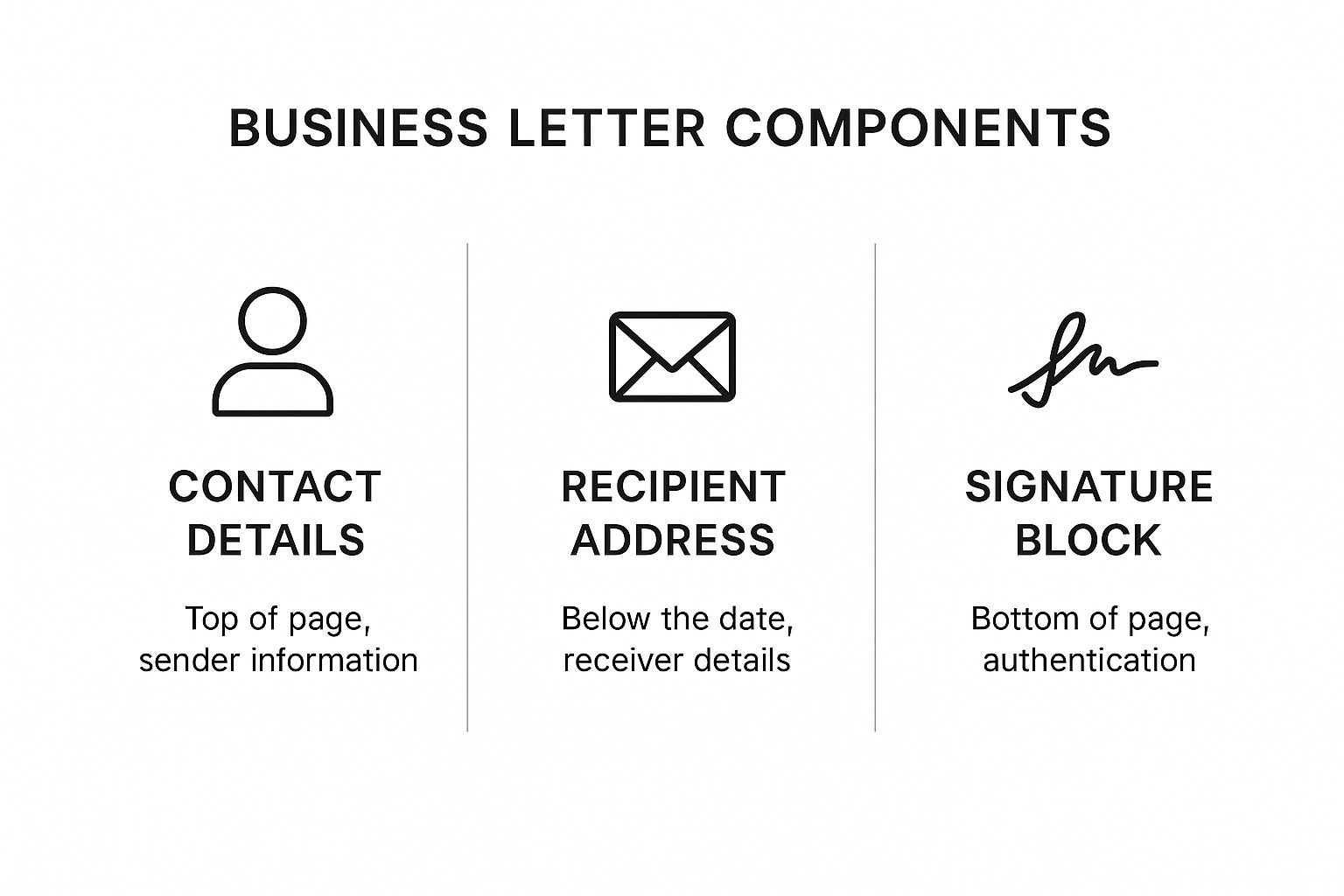
This visual map highlights the logical flow of a professional letter, starting with the sender at the top and ending with the formal sign-off at the bottom.
The Date and Recipient's Address
After your contact details, leave a single blank line and then add the date. This is more than just a timestamp; it’s an official record of when the correspondence was sent, which is vital for any legal or archival needs.
Australian business conventions, which were solidified over a century ago, really emphasise structured formats to ensure total clarity. This includes the 'day month year' sequence (e.g., 24 October 2024) to avoid any international mix-ups. You can find more on these official guidelines in the Australian Government Style Manual.
Leave another blank line, and then it’s time for the recipient's information, often called the inside address. This should be just as professional as your own details:
- Recipient's Full Name and Title: (e.g., Ms Jane Smith, Managing Director)
- Company Name:
- Company's Full Address:
Getting this part right is paramount. A mistake in the address can cause delays, while a misspelled name can get the whole conversation off on the wrong foot before it even starts.
Crafting the Salutation and Body
The salutation is your greeting, and its formality depends entirely on your relationship with the person you’re writing to.
For a formal letter where you know the recipient's name, "Dear Mr Jones" or "Dear Dr Chen" is standard. If you don't know their name, "Dear Sir or Madam" or "To Whom It May Concern" are traditional choices, though a more targeted title like "Dear Hiring Manager" is often much better.
The body of the letter is where you deliver your message—the main structure of your building. For the best readability, keep your paragraphs short (just one to three sentences is ideal) and focused on a single idea. Use the first paragraph to get straight to the point, the middle paragraphs to provide the details, and the final paragraph to wrap things up or state your desired next step.
The Closing, Signature, and Enclosures
Just as every building needs a solid entrance, it needs a proper exit. The complimentary close is the polite sign-off before your signature. Common choices in Australia are "Yours sincerely" (when you've used the recipient's name) and "Yours faithfully" (when you've used a generic salutation).
Leave a good few blank lines (three to four is standard) after the closing for your handwritten signature. This space is crucial—your signature authenticates the document and adds a necessary personal touch. Below this space, type out your full name and job title.
Finally, if you’ve included other documents with your letter, you need to say so. At the very bottom, after your typed name, write "Enclosure" or "Encl." This simple note alerts the recipient to look for the extra materials, ensuring nothing important gets missed.
To help you remember all these pieces, here’s a quick reference table.
Key Components of a Business Letter
| Component | Purpose and Formatting Notes |
|---|---|
| Sender's Contact Info | Identifies you. Placed at the top left (or pre-printed on letterhead). |
| Date | Records when the letter was sent. Use 'day month year' format (e.g., 24 October 2024). |
| Recipient's Address | The 'inside address'. Ensures the letter reaches the right person. |
| Salutation | The greeting. "Dear Mr Smith," or "Dear Hiring Manager." Tailor it to your relationship. |
| Body | The main message. Keep paragraphs short and focused. |
| Complimentary Close | The sign-off. "Yours sincerely" or "Yours faithfully." |
| Signature | Your handwritten signature goes here, authenticating the letter. |
| Typed Name & Title | Your full name and role, typed below the signature space. |
| Enclosures | A note at the bottom ("Encl.") if you've included other documents. |
Having this structure down pat ensures your message is not just read, but also received with the professionalism it deserves.
Choosing the Right Business Letter Layout
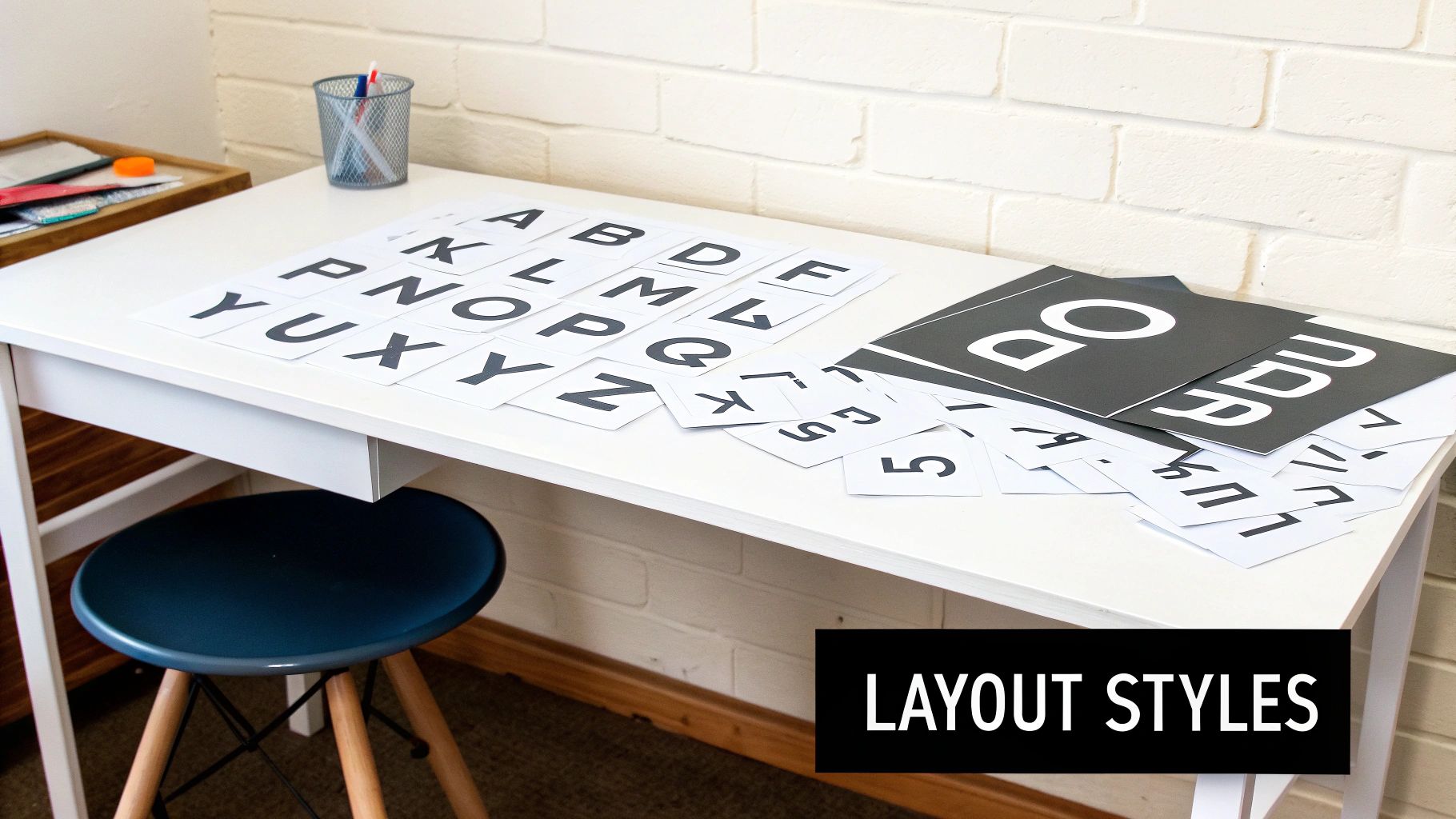
Once you’ve got all the essential parts of a professional letter ready, the next step is arranging them on the page. Think of the layout as the dress code for your message.
Just as you'd choose a modern business suit over a classic blazer depending on the occasion, the business letter format you select sends a powerful visual cue about your brand and the formality of your message.
In Australia, business correspondence generally sticks to one of three primary styles: Full Block, Modified Block, and Semi-Block. Each has a unique alignment and spacing, giving it a distinct look and feel. Getting this right ensures your letter's appearance perfectly matches its content.
The Full Block Format: The Modern Standard
The Full Block format is easily the most common layout you’ll see today. It’s favoured for its simplicity and clean, professional appearance. Imagine a perfectly straight line running down the left side of your page—every single component, from your address to your signature, lines up against it.
There are absolutely no indents in this format. This strict left-alignment creates a crisp, organised look that’s easy to read and even easier to type. It's the go-to choice for most modern business communications, from cover letters to official notices.
Here’s what defines the Full Block style:
- All text is aligned to the left margin. This includes your contact information, the date, the recipient's address, the salutation, every paragraph, the closing, and your signature.
- Paragraphs are separated by a double space. Instead of indenting the first line, you just hit enter twice to create a clean visual break between paragraphs.
This layout is efficient and projects a sense of modern professionalism. It’s a safe, strong choice for almost any business context. Mastering styles like this one starts with understanding the basic rules of how to format a letter.
The Modified Block Format: A Touch of Tradition
If the Full Block format is a sharp, modern suit, then the Modified Block is its classic, traditional cousin. It keeps much of the same structure but introduces one key visual difference: the placement of your return address, the date, and the closing.
With this layout, the body of the letter and the recipient's details stay aligned to the left margin. However, your address, the date, and the complimentary close (like "Yours sincerely") are all shifted over to the right of the page's centre point.
This subtle shift breaks up the strict vertical line of the Full Block format, giving the letter a slightly more traditional and less rigid feel. It strikes a balance between formal structure and classic design, making it a popular choice in more conservative industries.
Paragraphs in a Modified Block letter are typically left-aligned, just like in the Full Block style, with a double space between them to keep things clean.
The Semi-Block Format: The Most Traditional Layout
The Semi-Block format, sometimes called the Indented format, takes the traditional feel of the Modified Block one step further. It is the most classic and formal of the three layouts, though it’s used much less frequently in contemporary business settings.
Like the Modified Block, your address, the date, and the closing are all positioned to the right of the page's centre. The main difference is how the paragraphs are handled.
In the Semi-Block format, the first line of each paragraph is indented. You’d typically do this by pressing the Tab key once, which creates that classic visual cue that a new paragraph has begun. This style harks back to traditional letter writing and is sometimes used for very formal or personal business correspondence.
Because it requires more careful formatting with its indents, the Semi-Block style has largely been replaced by the simpler Full Block and Modified Block layouts for everyday business. Still, it's useful to recognise it to understand different levels of formality.
Comparison of Business Letter Format Styles
Choosing the best format often comes down to your company's brand and the context of your message. A tech startup might lean towards the sleek Full Block style, while a long-established law firm might prefer the classic look of the Modified Block.
To help you decide, this table breaks down the key differences at a glance.
| Formatting Style | Paragraph Alignment | Sender's Address & Date Alignment | Best For |
|---|---|---|---|
| Full Block | Left-aligned, no indents | Left-aligned | Most modern business correspondence, cover letters, and official notices. |
| Modified Block | Left-aligned, no indents | Right of centre | Traditional business settings, formal letters, and when a classic look is desired. |
| Semi-Block | Indented first line | Right of centre | Very formal or personal business correspondence where a highly traditional style is appropriate. |
Ultimately, each style serves a purpose. By picking the one that aligns with your message's tone and your company's image, you add another layer of professionalism to your communication.
Writing Content with Clarity and Impact
A perfect business letter format is like a polished frame, but the real masterpiece is the message inside. Now that we've sorted out the structure, it's time to shift from layout to language. The words you choose are what truly persuade, inform, and drive action, turning a well-formatted document into a powerful communication tool.
Crafting clear, concise, and professional content is what elevates your letters from good to great. It's all about choosing your words with precision, adopting a confident tone, and making sure your message is understood immediately, without any room for confusion. You want the substance of your letter to be just as strong as its presentation.
Adopting an Active and Confident Tone
The most effective business letters are written in an active voice. This is a simple but powerful technique that makes your writing more direct, energetic, and much easier to read. An active sentence has the subject performing the action, which naturally sounds more confident and uses fewer words.
A passive voice, on the other hand, can make your writing feel weak, evasive, or overly bureaucratic. It often uses more words to say less and can hide who is actually responsible for the action. Just by flipping passive sentences into active ones, you can instantly add clarity and impact to your letter.
Here’s a quick comparison to show what I mean:
- Passive: The report was completed by our team on Tuesday.
- Active: Our team completed the report on Tuesday.
See the difference? The active version is shorter, clearer, and gets straight to the point. It leaves no doubt about who did what, projecting competence and ownership.
Cutting Through the Clutter with Clear Language
Corporate jargon and needlessly complex words are the enemies of clear communication. They can alienate your reader and muddy your message, forcing them to guess what you actually mean. The goal is to be professional, not to sound like a textbook.
True professionalism isn't about using big words; it's about conveying complex ideas with simple, precise language. Your reader will appreciate the clarity and respect you for getting straight to the point without the fluff.
For example, instead of using bloated corporate phrases, always opt for their simpler, more direct alternatives. This one change will make your writing far more accessible and effective.
Here are some common culprits to avoid and what you can use instead:
- Instead of "going forward," just use "in the future."
- Instead of "due to the fact that," simply say "because."
- Instead of "at this point in time," try "now" or "currently."
Before and After Examples
Putting these principles into practice makes a dramatic difference. Let’s take a weak, passive, and jargon-filled paragraph and transform it into a clear and impactful statement.
Before:
"It has been decided by management that the implementation of the new software will be initiated next month. It is believed that this action will have a positive impact on our operational efficiency. Further information will be provided to all staff members in due course."
After:
"Management has decided to implement the new software next month. We believe this will improve our operational efficiency. We will provide all staff with more information soon."
The "after" version is direct, confident, and easy to understand. By prioritising clarity, using an active voice, and cutting out the jargon, you ensure the content of your business letter is as polished and professional as its formatting.
Real-World Australian Business Letter Examples
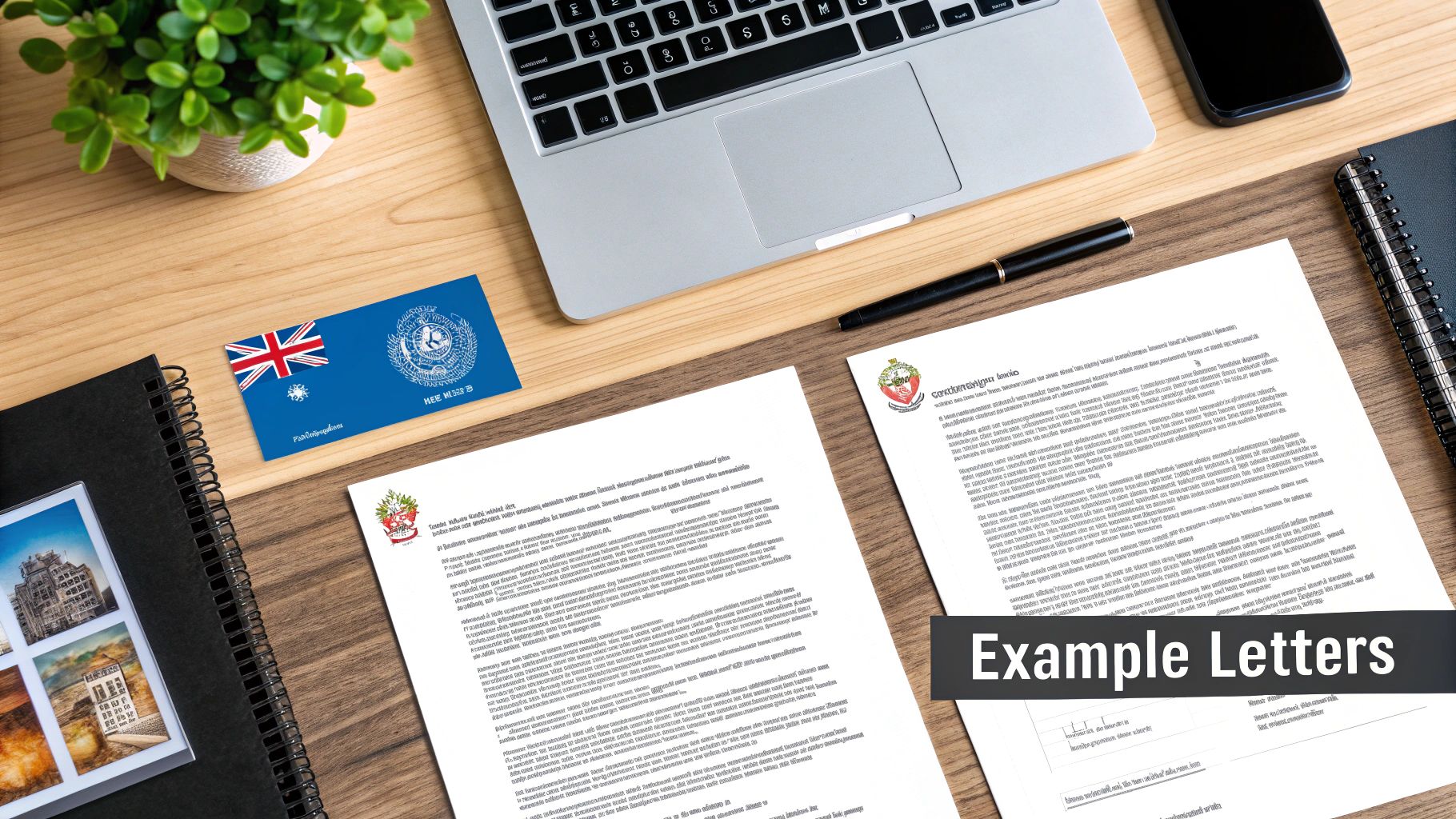
Theory gives you the building blocks, but it’s seeing the rules in action that really makes everything click. Let's move from the 'what' and 'why' to the 'how' by looking at some practical templates for common Australian business scenarios. Think of this as your hands-on workshop for getting professional letters right every time.
Each example uses a different business letter format, showing you how the layout can change to suit the message. These aren't just templates to copy and paste. They’re adaptable models designed to show you how all the pieces—from the greeting to the final sign-off—come together to create a polished, effective document.
Example 1: Cover Letter Using Full Block Format
A cover letter is your first handshake with a potential employer, so a clean, modern look is non-negotiable. The Full Block format is perfect for this. Its strict left alignment creates a sharp, organised document that’s incredibly easy to read and projects pure professionalism.
Because every single line starts at the left margin, there’s no fuss and no clutter. Let's break down a sample cover letter for a Marketing Coordinator role in Sydney.
Why Full Block Works Here: Its straightforward structure lets your skills and experience take centre stage. Recruiters scan documents in seconds, and the clean lines of the Full Block format make your letter easy to digest and immediately professional.
[Your Name]
15 Collins Street
Melbourne VIC 3000
0400 123 456
your.email@email.com.au
24 October 2024
Ms Amelia Chen
Hiring Manager
Innovate Solutions Pty Ltd
Level 5, 200 George Street
Sydney NSW 2000
Dear Ms Chen,
I am writing to express my enthusiastic interest in the Marketing Coordinator position at Innovate Solutions, as advertised on SEEK.com.au. With over three years of experience in digital marketing and a proven track record of executing successful campaigns, I am confident I possess the skills and passion necessary to contribute to your team.
In my previous role at Digital Growth Agency, I was responsible for managing social media accounts, creating engaging content, and analysing campaign performance. A key achievement was developing a content strategy that increased client engagement by 35% in six months. My skills in SEO, email marketing, and data analysis align perfectly with the requirements outlined in your job description.
I have long admired Innovate Solutions' commitment to sustainability and its forward-thinking approach to technology. I am eager for the opportunity to bring my experience to a company with such a strong vision.
Thank you for considering my application. My resume is attached for your review, and I look forward to discussing how I can add value to Innovate Solutions.
Yours sincerely,
(Your handwritten signature)
[Your Typed Name]
Enclosure
Example 2: Formal Complaint Using Modified Block Format
When you’re lodging a formal complaint, your tone needs to be serious but respectful, and the layout should reflect that. The Modified Block format is a great choice here because it balances readability with a touch of traditional formality.
By shifting the sender's address, date, and closing to the right, it creates a more classic feel than the stark, modern Full Block style. This subtle visual tweak can help convey a sense of considered, serious correspondence without looking dated.
Here’s a letter to an electronics company about a faulty product. You'll notice the body text stays left-aligned, so it's still perfectly easy to read.
- Sender's Address & Date: Shifted over to the right of the centre.
- Complimentary Close & Signature: Also aligned to the right.
- Paragraphs: Kept to the left, with no indents.
123 Swanston Street
Perth WA 6000
24 October 2024
Customer Service Manager
TechGadget Australia
PO Box 500
North Ryde NSW 1670
Dear Sir or Madam,
Subject: Formal Complaint Regarding Faulty Product (Order #TG789123)
I am writing to lodge a formal complaint about a defective 'SoundMax Pro' headphones I purchased from your website on 1 October 2024. Despite following all setup instructions, the right earbud fails to produce any sound, rendering the product unusable for its intended purpose.
The product was delivered on 5 October 2024, and the issue was apparent immediately upon first use. I have attempted the troubleshooting steps listed on your support page to no avail. As the product is not of acceptable quality and is therefore in breach of Australian Consumer Law guarantees, I request a full refund.
I have attached a copy of my proof of purchase for your reference. I expect to receive a response outlining the steps for returning the faulty item and processing my refund within 10 business days.
I trust we can resolve this matter promptly. I look forward to your reply.
Yours faithfully,
(Your handwritten signature)
[Your Typed Name]
Encl: Proof of Purchase
Common Formatting Mistakes to Avoid
Even the most thoughtfully written message can be completely let down by small formatting mistakes. These slips might seem minor, but they often signal a lack of attention to detail, weakening your letter's professional punch. Think of this section as your final quality check, helping you spot the common traps that catch out even experienced writers.
By learning to recognise these frequent errors, you can start proofreading your letters with an expert eye. This ensures every piece of mail you send is polished, professional, and error-free, backing up the credibility of your message from the first glance to the final sign-off.
Addressing and Salutation Errors
One of the most frequent—and damaging—mistakes is getting the recipient's details wrong. A misspelled name or an incorrect job title can start the conversation on a sour note, suggesting you haven't bothered to do your basic homework.
Another common slip-up is a mismatched salutation and closing. Remember the golden rule of Australian business correspondence:
- "Yours sincerely" is used when you address a specific person by name (e.g., "Dear Ms Jones").
- "Yours faithfully" is reserved for generic salutations (e.g., "Dear Sir or Madam").
Forgetting a handwritten signature is another critical oversight. In a physical letter, the space between the complimentary close and your typed name is reserved for your signature in ink. It authenticates the document and adds a vital personal touch that should never be skipped.
Inconsistent Alignment and Spacing
Choosing a layout like Full Block or Modified Block is only half the battle; you have to stick with it. A common mistake is mixing elements from different styles, like indenting paragraphs in a Full Block letter or left-aligning the date in a Modified Block format.
This just creates a messy, unprofessional look that distracts from what you're trying to say. In the same way, inconsistent spacing between sections—like having one blank line after the date but three after the salutation—disrupts the visual flow of the letter. Consistency is key to creating a clean, readable document.
Another crucial detail is the recipient's address. With Australia Post delivering to an ever-expanding network, which grew from 12.4 million to 12.6 million addresses in just one year, perfect accuracy is non-negotiable. An incorrectly formatted address can lead to big delivery delays or even failures, as you can see in more detail in Australia Post's operational framework. Always double-check postcodes and suburb names to make sure your letter gets where it needs to go without a hitch.
Your Letter Formatting Questions, Answered
Even with the best templates in hand, a few tricky questions always seem to pop up right when you’re about to finalise your letter. Nailing these small details is what separates a good letter from a great one, giving it that final professional polish.
Here are some quick, clear answers to the most common queries we see about the Australian business letter format.
What’s the Real Difference Between Full Block and Modified Block?
The main difference comes down to alignment, and it creates a completely different visual feel.
With the Full Block format, everything gets aligned to the left margin. Your address, the date, the closing—it all lines up perfectly on the left. This gives the letter a very clean, modern, and streamlined look. It’s popular because it’s so straightforward.
Modified Block, on the other hand, is a bit more traditional. While the main body of your letter stays left-aligned, your address, the date, and the closing get shifted over to the centre-right of the page.
When Do I Use ‘Yours Faithfully’ vs ‘Yours Sincerely’?
This is one of those classic rules that shows you really know your stuff when it comes to formal Australian correspondence. It’s simple, but getting it right matters.
- Use ‘Yours sincerely’ when you’ve addressed the person by name in your greeting (e.g., ‘Dear Ms Jones’). You know who you’re writing to, so you’re being sincere.
- Use ‘Yours faithfully’ when you’ve started with a generic salutation like ‘Dear Sir/Madam’ or ‘To Whom It May Concern’. You’re writing out of faith that the right person will receive it.
Getting this small detail right is a hallmark of truly professional communication. It signals that you understand the established conventions of formal letter writing, which can subtly boost your credibility with the reader before they even finish the letter.
Is a Handwritten Signature Still Necessary?
Yes, absolutely. In a world of digital everything, a real signature still carries a lot of weight.
For any letter you print and post, a handwritten signature in blue or black ink is non-negotiable. It sits right between your closing (‘Yours sincerely’) and your typed name. More than just a tradition, it authenticates the document and adds a personal touch that typed text just can’t match.
And if you’re sending the letter as a PDF? You’ll want to insert a high-quality scan of your signature in that same spot. This maintains the expected level of formality and shows you’ve taken the time to validate the document properly.
For all your software needs, from operating systems like Windows 11 Pro to essential office tools, Digital Hub Key offers genuine, instantly delivered activation keys. Get the licensed software you need to work professionally and securely by visiting https://digitalhubkey.com today.

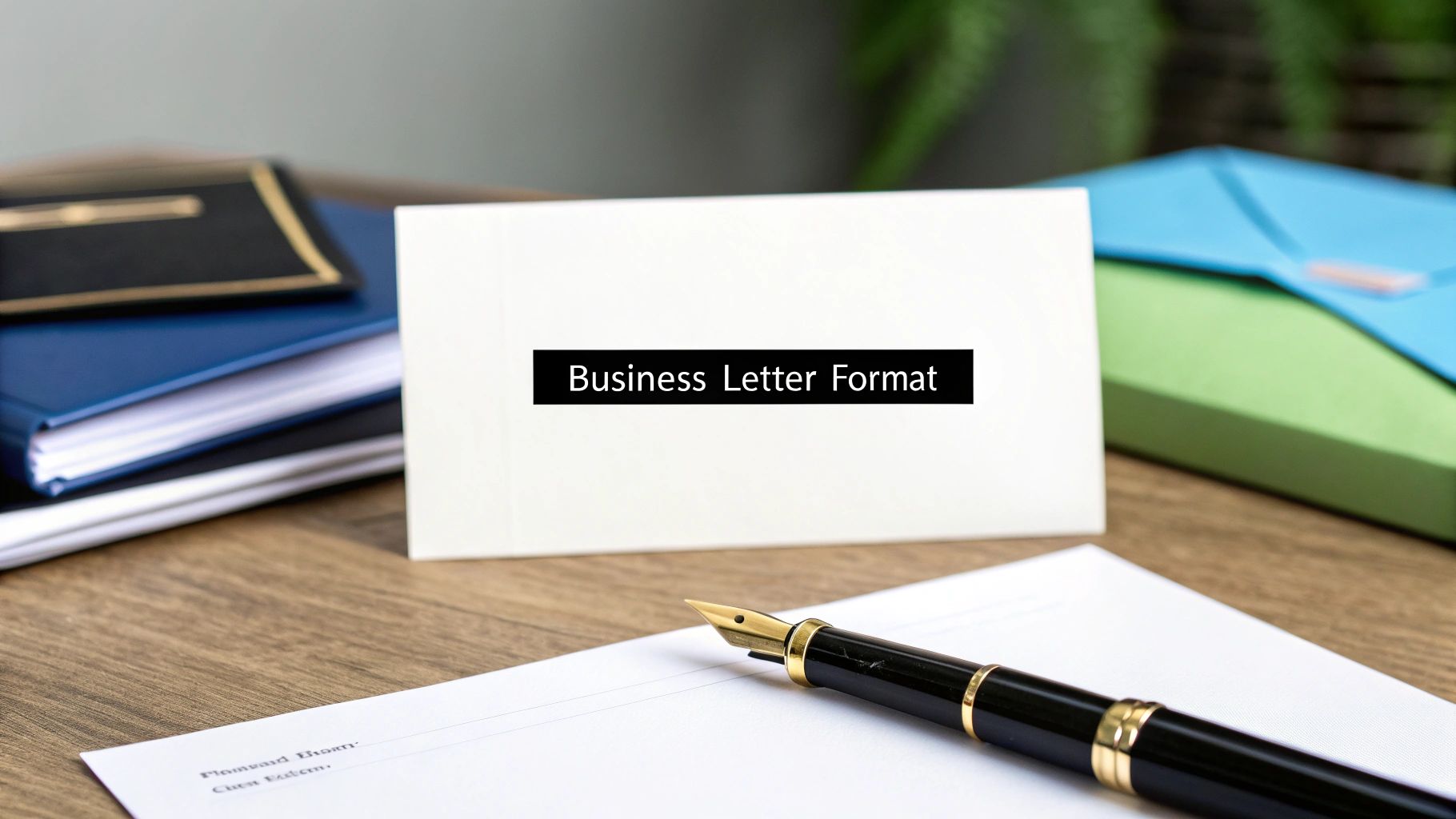




[…] in Excel as a fantastic next step. You might also find our guide on crafting a professional business letter format useful for other professional […]